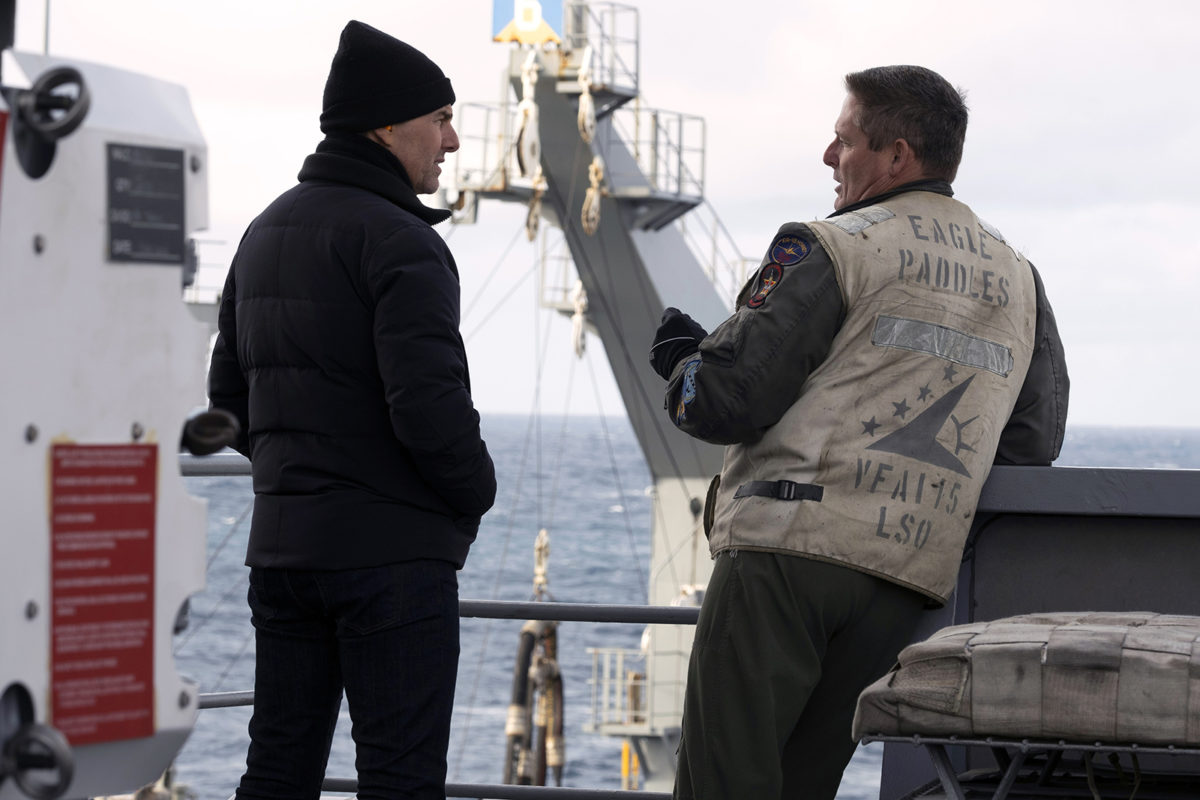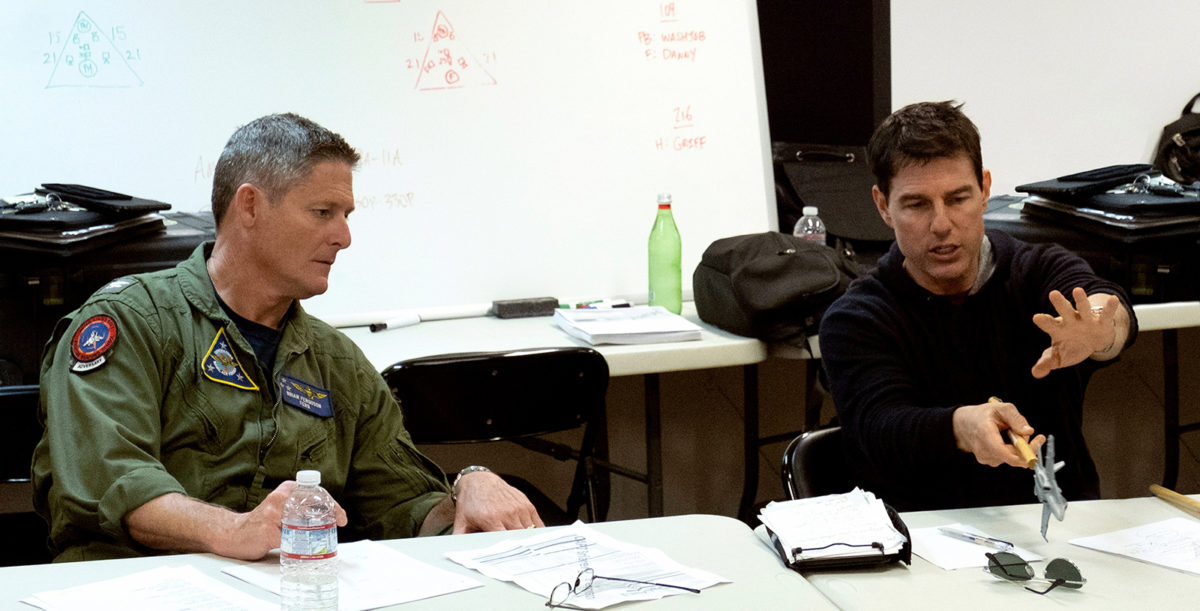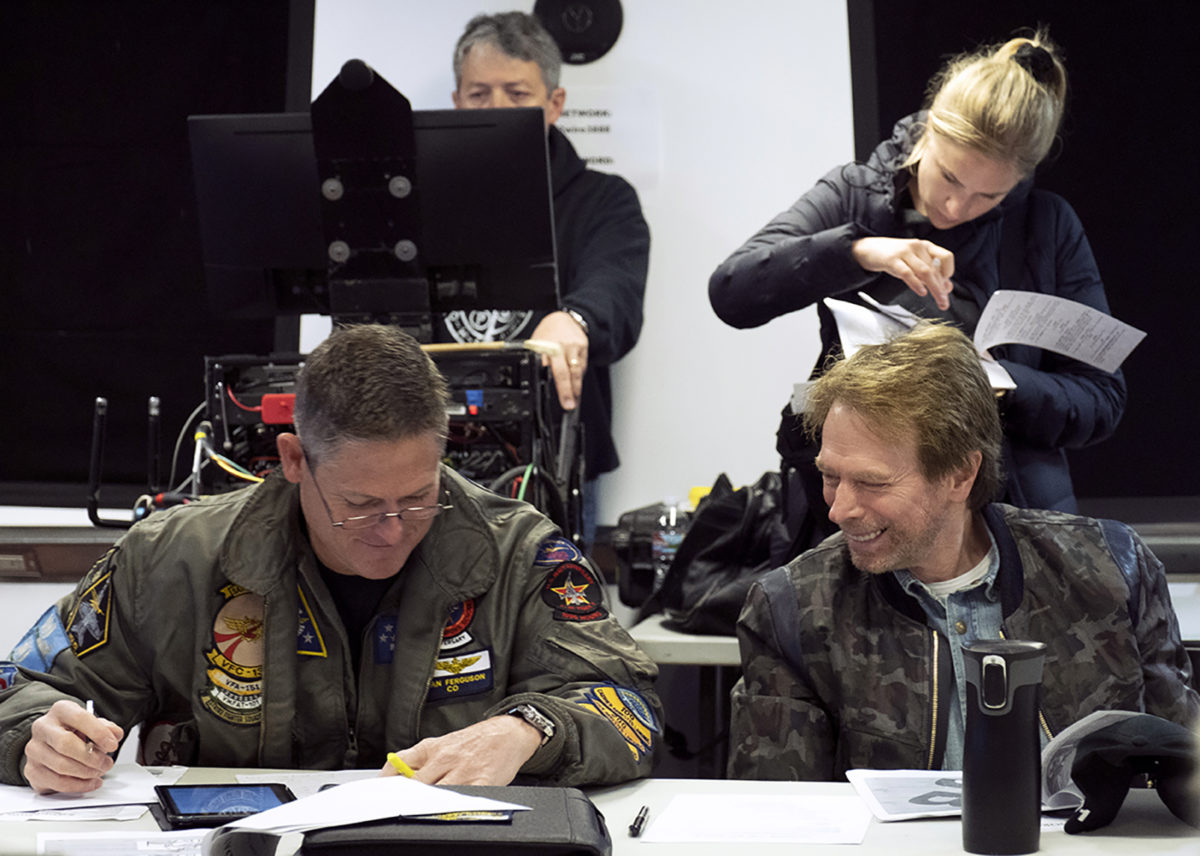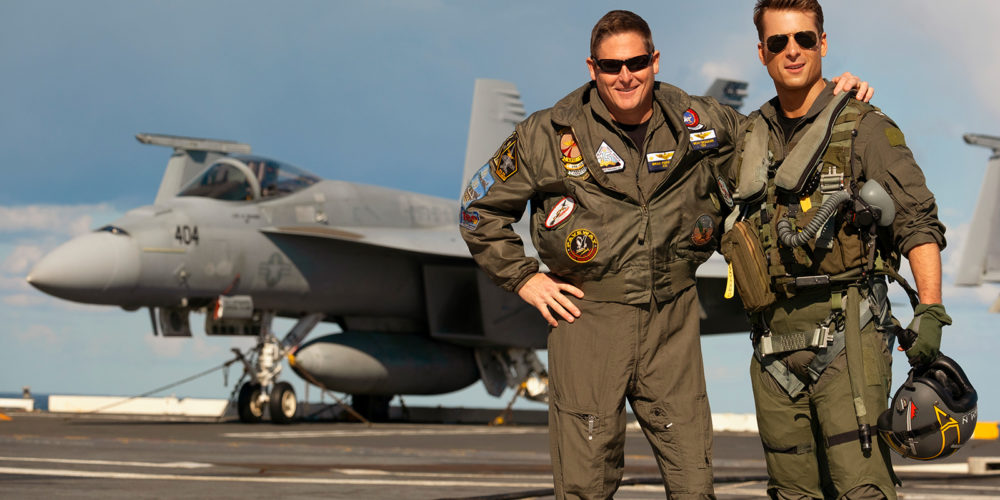Like many serving in the military, Capt. Brian “Ferg” Ferguson (’93) has spent his career among unsung heroes. However, with the premiere of “Top Gun: Maverick,” he is sharing the spotlight with superstars and the Super Hornet.
The premieres and the press events alongside Tom Cruise and Jerry Bruckheimer are the culmination of his more than a year of daily duty as a technical director on the film. A moment of screen time as “fighter pilot in bar,” makes him a rare TOPGUN mentioned in IMDB.
“I joined the Navy because of the first ‘Top Gun,’ and it would be nice to move toward retirement by helping recruit and retain the next generation of Naval Aviators. It felt like I was bringing my career full circle,” Ferguson said.
His commitment of a few months to the movie turned into four years. A year of that was active duty, making a film that Ferguson sees as more than a summer blockbuster. “Top Gun: Maverick” promotes the skill and professionalism of fliers and renews our pride in them.
“We have not always acknowledged our heroes as we should,” he said. “I hope this movie rekindles national pride in our military. When people come back from a deployment, I hope they get accolades.
“We don’t do what we do for the thanks, but I hope people understand what service, and the Navy in particular, are all about after this movie. The technology is cool, and I love flying the F-18, but the Sailors, Chiefs and Officers are the real story. Families who send their loved ones into harm’s way, then wonder and worry, have the hardest job of all.”

However, he acknowledges that the F/A-18E/F Super Hornet is one of the stars of the show, just as the F-14 Tomcat drew audiences to the original movie in 1986. “Everybody loved the F-14 when the first movie came out. Everybody had the models. Everybody had the posters. Everybody had the jackets. I had all that stuff. It got me into the Navy.”
Long before the new movie hit the big screen, Ferguson saw rough cuts and worked with the production experts to add special effects, lighting and sound. Although there is minimal CGI in the movie, he came away impressed by what the team produced.
“The bad guy — the black airplane — is the SU-57, and we don’t have access to those,” he said of the Russian Sukhoi multirole fighter stealth jet. “We shot other aircraft such as the F-18, or L-39 or F-5 executing the maneuvers and the magicians would turn it into a realistic image. I made sure the flight controls moved the right way and the maneuvers matched the real thing.”
“I joined the Navy because of the first ‘Top Gun,’ and it would be nice to move toward retirement by helping recruit and retain the next generation of Naval Aviators. It felt like I was bringing my career full circle.”
— Capt. Brian Ferguson (’93)
One of his favorite moments is when the pilots come off target and defend against surface-to-air missiles. During filming, he advised that the airplanes were too close together and the scene needed more missiles in the air and smoke trails everywhere. They would also be stepping all over each other on the radio.
“I had the team watch unclassified videos of similar engagements in Iraq so they could appreciate the intensity,” he said.
What the audience sees is less chaotic than what Ferguson has experienced as a fighter pilot, but he feels it is still realistic. He knew he would hear about it from his peers if it wasn’t. “We can be a sarcastic bunch with a dark sense of humor,” he says. When friends spotted his cameo in the movie, messages flooded in, but he accepted it with good humor.
Working with TOPGUN instructors, he also fielded questions from the actors about fighter and strike tactics … and wardrobe details. They were disappointed not to wear their squadron patches in the scene where they launch off the carrier into combat. He explained, “That would be unrealistic. We would want to be unidentifiable if we were shot down. We would leave them on the boat.”
When performers rehearsed in a mockup of a cockpit, he advised them on how they would be moving and where to focus their eyes. “When a fighter pilot watches these scenes, that pilot is going to think: Wow, they got it right.”

Most of the questions came from Tom Cruise. “He is a very inquisitive guy,” Ferguson said. Cruise even asked for advice on how he would respond to being yelled at by an admiral. Ferguson didn’t have direct experience here but advised the actor to keep eyes front. Although Cruise is an experienced pilot, he was always willing to put safety ahead of spectacle. “He trusted me to know what the plane and the pilots could and could not do.”
Risk management remained his priority throughout the collaboration of bringing the script to the screen. “I would sit with Aerial Coordinator Kevin LaRosa Jr. and Director Joe Kosinksi and Tom Cruise, and we would work through how to get the effect we wanted. We would take models on sticks to represent F-18s to get the basic vision and film them on iPhones. Then I would sit down with pilots and figure out how we would do it safely. Then we would do a safety briefing, determining: Where is the sun? What’s in the background? How close can the planes get and remain safe?
There was endless coordination to ensure that no one filming or flying got hurt “and we didn’t crash a taxpayers’ airplane.” The flyaway cost of the F/A-18F Super Hornet is an estimated $65 million.
Ferguson’s adventures as a career pilot started at Embry-Riddle in Daytona Beach. “I fly with military guys. I fly with civilians in the airlines. The fliers who went to Embry-Riddle? Well, it shows. You get the Riddle product, and it’s all very good and predictable.
“Riddle pilots are consistent in using checklists and procedures, and they learn to follow the process to do things the right way. Nobody cuts corners. So I was prepared well.”
Not only did he learn to fly, he met a key advisor under the Pitts biplane that once hung in the old student center. Susan Tworek (’91), now his wife of 28 years, was studying aviation business. He was in the Naval Aviation Club, she was in the Ninety-Nines, and they met during a club orientation.
When the movie opportunity came up, Ferguson was a reservist and flying for Delta Air Lines. Susan is a contractor for the FAA in the Southern California TRACON. He wasn’t sure he was the best choice for the movie assignment, but Susan pointed out, “If the movie got the details wrong, you would complain, and if it is awesome, you’ll regret you had nothing to do with it.”

In picking fliers for the movie, Ferguson did not make the predictable choice of squadron COs, Blue Angels or 3,000-hour F-18 pilots. “I deliberately used young lieutenants just off their first deployment. The amazing stuff you see is not from the handpicked ‘best of the best,’ so when the world watches, I want them to know that for the most part, they are seeing basic Fleet aviators doing incredible flying.”
The screening that mattered most to Ferguson was in 2020, with his bosses in the audience. “The three-stars I reported to watched what we hoped was a final version. The Admiral that runs all of Naval Aviation had to provide the final approval to Paramount on behalf of the U.S. Navy.”
They were ready to share the movie with the world and then Covid-19 closed theaters. It was a long wait to see it, but Ferguson jokes, “I made up for it by seeing it at least 10 times in the last three weeks.”
In May, the movie premiered to an all-Navy audience, including the Secretary of the Navy, at North Island Naval Air Station in San Diego, one of the movie locations. The same day, there was a premiere in downtown San Diego.
Ferguson says that an audience changes the experience. “The first time we saw it, I thought, ‘That’s a pretty good movie. We did OK.’” When he saw it again in an audience full of people clapping and cheering, he knew it was a hit.
After “Top Gun: Maverick” wrapped, Ferguson served as technical advisor for a movie set on an aircraft carrier during the Korean War. “I had to get smart on the F-4U Corsair and how the flight deck operated in the ’50s.”
“Devotion” is set for release this fall. The movie, based on a 2014 biography by Adam Makos, follows pair of fighter pilots who become two of the U.S. Navy’s most celebrated wingmen. Real aircraft featured in the film include F4 Corsairs, an AD Skyraider, F8F Bearcat fighters, a MiG-15 and a HO5S-1 helicopter.
Ferguson doesn’t rule out more movie work. “I’m not out there looking, but I would certainly do it if the story was right. These were great stories, and I was honored to be a part of them.”
Even without the cameras rolling, his career has had its share of drama and action. “You don’t have to be flying jets for the Navy to be a great adventure. You will make lifelong friends. You won’t get rich. You will go to funerals. It’s hard. But it is worth it.”
